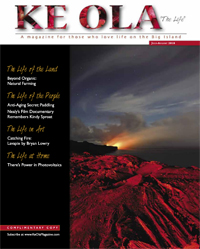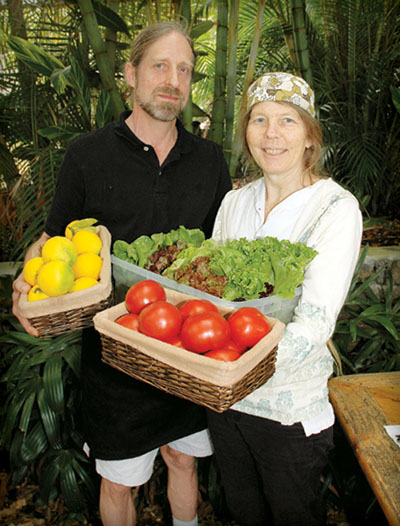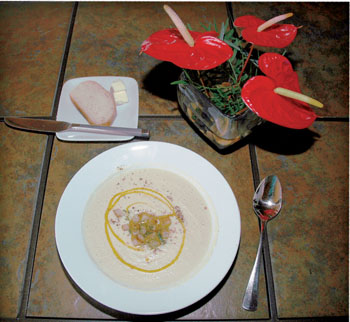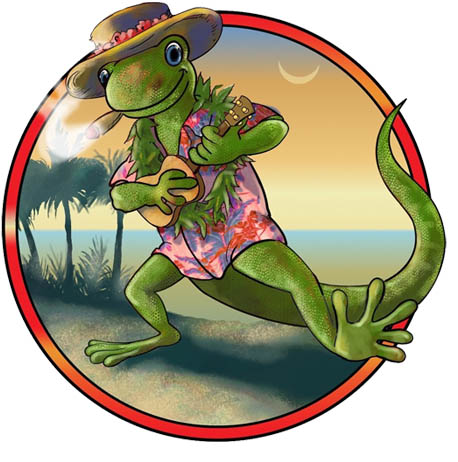
Holuakoa Gardens Restaurant and Café: Connecting the Plate with the Planet via Slow Food

By Fern Gavelek
Handmade potato gnocchi…house-cured bacon…homemade fresh pasta lasagna…
Admit it—the above is not your normal restaurant fare. They can be had, however, in the heart of Holualoa village at Holuakoa Gardens Restaurant. The delicious, labor-intensive delicacies illustrate the restaurant’s philosophy toward food, which “combines pleasure with responsibility.”
“We’re a Slow Food establishment, committed to a food system that is based on the principles of high quality and taste, environmental sustainability and social justice—in essence, a food system that is good, clean and fair,” reads the restaurant’s mission statement.
True to the tenets of the Slow Food movement, owners Chef Wilson Read and partner Barb Gerrits don’t sutbscribe to fast food and fast life. They disdain the disappearance of local food traditions—such as making pasta and tortillas from scratch.
As Slow Food proponents, the couple hopes to reverse people’s dwindling interest in the food they eat—where it comes from, how it tastes and how our food choices affect our community. And they’re doing it one entrée and soup at a time.
Fresh Food

Slow Food, which was founded as a non-profit in 1989, believes food that tastes good gives us pleasure. To get that fresh taste, it advocates for growing and using seasonal food that is harvested when perfectly ripe. In addition, locally suitable varieties of food should be used, rather than those that withstand long-distance transportation. Fewer food miles means less transport time and less packaging means less pollution.
“We try to get our food from Holualoa sources and others as close as possible, but Holualoa first,” says Chef Read, who studied cooking at the French Culinary Institute in New York City. “We support our producers by offering a daily changing menu based on the food they can provide. And what we don’t use, we let our farmers sell at our Saturday farmers market.”
Those farms include Chez Marquis for figs, citrus, bananas and veggies; Holualoa Organic for arugula, tatsoi, mustards, rainbow carrots, turnips and heirloom tomatoes; Lehualani Farm for rainbow lettuces, Adaptations for organic produce and Kona Blue Sky for coffee.
Clean Food
According to Slow Foodies, what we eat should be produced with respect to the environment, animal welfare and our health. It’s also better to have knowledge and control over what we eat and how it’s produced.
To practice these principals, Holuakoa uses pasture-raised beef from the Big Island. The grass-fed cattle range free for forage; they aren’t fattened up in feedlots and are free of antibiotics and hormones. Always on the dinner menu is grilled beef tenderloin, presented in a melt-in-your mouth Cabernet sauce and accompanied by red potatoes, crunchy purple wax beans, succulent cherry tomatoes and soft Boursin cheese.

Only locally-caught seafood is served. Chef Read, who spent some time as a young adult in Louisiana, doesn’t approve of the large-scale, commercial shrimp industry and so shrimp isn’t on the menu. “We currently can’t get free-range chicken so we aren’t serving it, except in chicken salad,” says Gerrits. Eggs are farm-fresh from Holualoa.
As part of the Holuakoa Pig Project 2010, the restaurant recently raised its own pigs at nearby Wai‘aha Farm, providing daily restaurant “slop” to feed the animals, along with spent grains from Kona Brewing Company. The pigs were harvested at the Big Isle’s Kulana Foods and are USDA approved.
“This project enabled us to use all of the animal—nose to tail,” details Chef Read, who butchered the pigs and has been curing his own bacon and smoking hams. For example, the jowls were dried for guanciale, Italian bacon made by rubbing salt and peppers into the meat and letting it cure for a few weeks.
Chef smoked some of the pork shoulder for tasso ham, a Louisiana specialty that’s marinated and richly seasoned. It’s served as a “small plate” with organic red beans, house-cured bacon and freshly baked cornbread.
Ever heard of confit? It’s a French culinary term used to describe meat cooked and preserved in its own fat. Find Chef’s own pork confit on the menu; it’s seared and accompanied with a savory white carrot puree, turnip greens, caramelized onion and red wine sauce.
Fair Food
Slow Food asserts that those who produce food should receive a fair wage and recognition for work. In addition, it’s everyone’s responsibility to protect the heritage of food by ensuring the survival of traditional, sustainable production methods and indigenous varieties. Otherwise, the belief is that the diversity of our food will be lost.
To that end, Chef Read gets to know his food producers, visiting them and understanding their challenges.
“Relationships are important, and I want growers to be appreciated,” says Chef Read. “We barter on pricing and keep things flexible so we both (restaurant and growers) can benefit from all our hard work.”
Chef supports agricultural diversity and uses heirloom and unusual varieties of veggies. Also called heritage foods, heirlooms are non-hybrid, open-pollinated cultivars that were commonly grown before industrialized agriculture. A must-try at Holuakoa is the creamy white carrot soup with its hint of ginger; it’s beautifully topped with sautéd carrots, thyme and a drizzle of Tuscan olive oil.
The couple concedes they must “ship in” food that’s locally unavailable: organic dried beans, lentils, peas, oils, some nuts and cheeses. Also brought in is a variety of organic flours, which Chef Read fashions into pastas and in-house baker Ryan Salerno, who trained at the New England Culinary Institute, uses for all the fresh baked bread, pizza dough, pastries and desserts, such as the fresh fruit cobbler—perfect with Holuakoa’s homemade ice cream.
Spelt, an old-world grain with reduced gluten, is used to concoct large, griddle-made pancakes, served with fresh island fruit, whipped cream and pure maple syrup. Gluten-free breads are served on the weekends.

Holuakoa culinary facts: Chef makes all his stocks from baked bones. He considers his demi-glaze or brown sauce to be one of his finest accomplishments. He’s proud of his homemade pasta and potato gnochi—it takes an hour just to make the pasta part of the tasty dumpling. Using self-described, classic French cooking techniques, Chef says he cooks “a la minute” (to order) and makes food in small amounts. “It’s creative cooking,” he muses.
Named for its upstairs holua sled made by esteemed Hawaiian artisan Herb Kane, Holuakoa has cozy seating in little nooks and crannies around a garden and koi pond. The main dining area has a courtyard feel across from the coffeehouse. All seating is covered, but open air.
The restaurant sells out on certain nights, maxing out at 60 for dinner. “We limit the amount of people we serve for dinner,” says Gerrits. “The Slow Food philosophy is to take pleasure in your food and the company you keep. We don’t rush people through here.”
It’s easy to jump on the Slow Food bandwagon—the concept considers consumers to be “co-producers.” The idea is that by being informed about how our food is produced and actively supporting those who produce it, we become a partner in the production process. Ready to go for a ride?
Holuakoa Garden Restaurant: brunch 10 a.m.-2:30 p.m. Tuesday-Friday and 9 a.m.-2:30 p.m. weekends. Dinner is served 5:30-8 p.m. Tuesday-Saturday. Full bar and wine list, local beers, organic ales and gluten-free beer. Reservations are recommended, 322.2233. Located on Mamalahoa Hwy. just north of the post office; parking also in rear.
Holuakoa Café: 6:30 a.m.-3 p.m. Monday-Friday and 8 a.m.-3 p.m. weekends. Serving specialty coffee drinks, fresh fruit smoothies, organic pastries and desserts, pre-made sandwiches, dips, salads and breads, plus fresh eggs and produce. Seating inside and out, carryout service. ❖
Holuakoa Farmers Market: 9 am–3 pm Saturdays
Photos by Fern Gavelek
Email Fern Gavelek at ferng@hawaii.rr.com.


